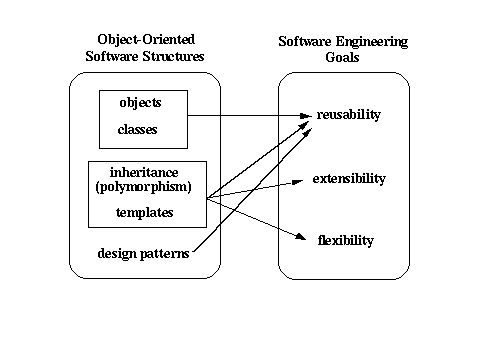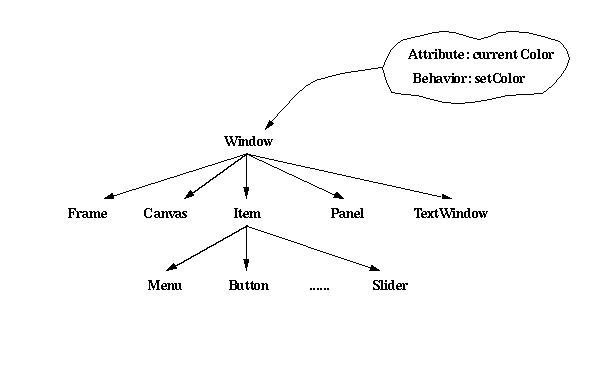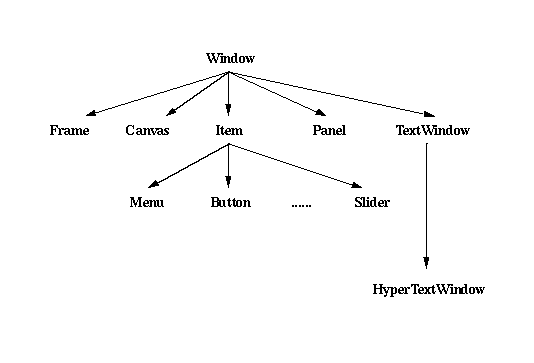| Software Engineering Goals |
|---|
 |
Object-oriented programming address (at least) the three major
software engineering goals shown in this figure:
| Software Engineering Goals |
|---|
 |
The language features that address these issues are those of objects, classes, inheritance, polymorphism, templates, and design patterns.
Reusability is an important issue in software engineering for at least two major reasons. First reusability is one means to cope with the pressures of producing ever larger and more functional systems in an ever decreasing development cycle (time to market). Reusability allows developers to be more efficient because the same code can be developed once and used in many different applications. Second, reliability can be improved by reusing previously developed, and previously tested, components. The development of new code entails the additional costs in time and money of testing, validation, and verification of the new code. Much of these expenses can be avoided by using "off-the-shelf" components.
Software reuse is certainly not a goal unique to object-oriented programming. While libraries of procedures proved this approach to be useful, in practice procedures were too primitive a unit to promote extensive reuse. Objects and classes are more sophisticated mechanisms for achieving software reuse because they bind together more completely all the aspects of an entire abstraction. Therefore, the abstraction can more easily be transported across applications. Any of the forms of generalization also contribute to reuse. A class in an inheritance hierarchy can be reused directly when it serves as a generalized base class from which a new class is derived by specialization. Templates can be reused by supplying different parameters for the template arguments. Design patterns allow design experience and success to be reused across designers.
Extensibility in software is important because software systems are long-lived and are subject to user's demands for new features and added capability. Object-oriented programming can help to satisfy this need through inheritance. Recall that inheritance is a generalization/specialization hierarchy. Referring to the Window hierarchy discussed earlier, extensibility is possible in two ways. The first way in which a generalization/specialization hierarchy supports extensibility is that any new attributes or behavior that is added to a more generalized concept (e.g., Window) will automatically become part of the attributes and behavior of its specializations (e.g., Frame, Item, Button). For example, as shown below, if the Window abstraction is enhanced to include a color with which the Window would be displayed on the screen, then the attribute "currentColor" and the behavior "setColor" might be added to Window. It would then be possible to manipulate the color of a Window but all its specializations as well.
| Adding new Attributes and Behavior |
|---|
 |
The second way in which a generalization/specialization hierarchy supports extensibility is that the hierarchy itself can be extended. New additions can be made under any existing node. For example, as shown below, the TextWindow might be specialized to a HyperTextWindow by including additional attributes and additional behavior that distinguishes ordinary words from those words that are hyperlink and can be clicked-on to transfer to another place in the text.
| Adding new Specialized Classes |
|---|
 |
Flexibility in software systems means, in part, that additions, variations or modification can be made without the need to modify numerous places in the system's code. Historically, many software systems were very brittle in that the addition of a small change could only be accomodated by making modifications in many, and often aparrently unrelated, parts of the existing system. This brittle property stood in marked contrast to the prevaling notion that, nlike hardware systems, software system were supposed to be extremely maleable and changes can be made easily.
Object-oriented programming contributes to flexibility in two ways. First, the separation of an interface from its implementation allows the user of the interface to remain unaffected by changes in the implementation. Thus, a modification can be made to the implementation (e.g., to improve its efficiency or reliability) without requiring any changes in the code that uses the interface. Second, polymorphism allows variations and additions to be made to the set of classes over which the polymorphism applies. For example, referring to the Window hierarchy, consider adding a new kind of interaction Item, a RadioButton. Since Items can be placed in a Panel, it would seem necessary to modify the Panel to allow a Panel to manipulate the newly created RadioButton. However, the Panel can use polymorphism so that the Panel's algorithms only rely on the more general attributes and behavior of an object (i.e., that it is a kind of Item) and does not need to be aware of the exact "type" (i.e., RadiButton) of the object. Using this approach, the Panel can be designed to operate on Items. Any newly created Item, even one - like the RadioButton - that is created after the Panel is already written, automatically can be manipulated by a Panel without changing the code of the Panel.

|
|